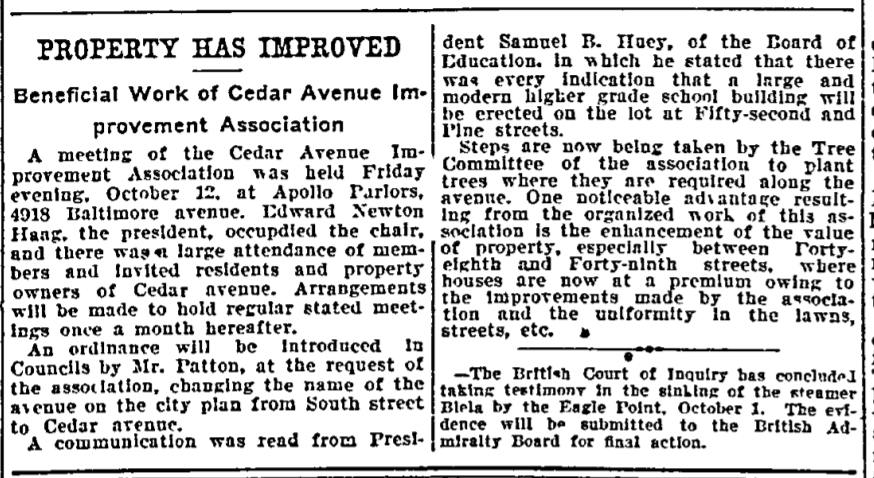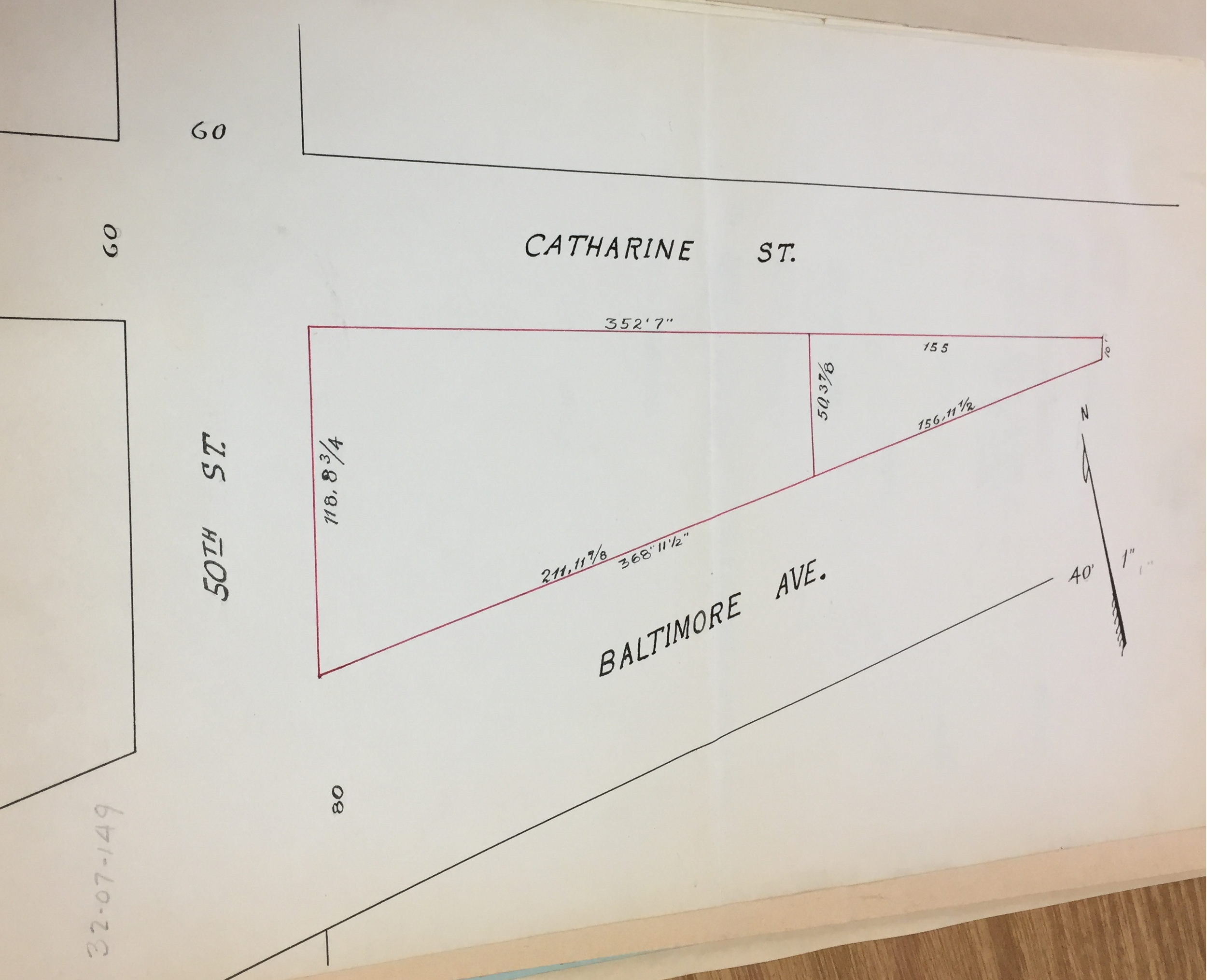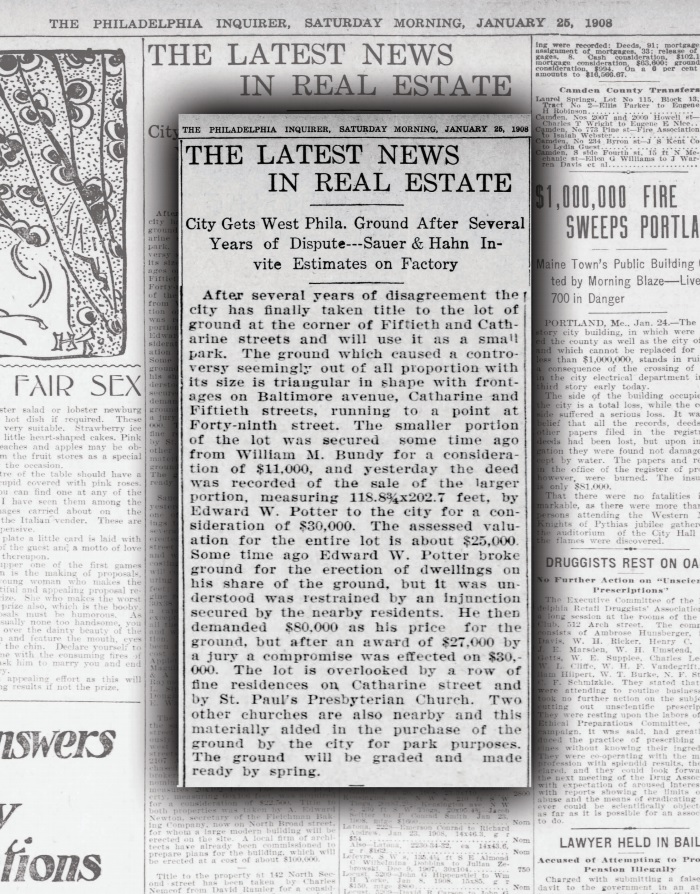The Origins OF the Namesake PARK

RESEARCHED AND WRITTEN BY Amara Rockar.

Cedar Park, the park, though totaling a mere half acre of land serves as the heart of our community. But how did our namesake park come to be and why is it seemingly named for an avenue two blocks north of its own boundaries?

The sign at the 49th Street entrance hints with its welcome to “Historic Cedar Park Established 1911.” Was Cedar Park a donation of undevelopable land to the city as with Clarence H. Clark’s gift of Clark Park to the east? Or was it created through an act of central city planning benevolence? The intriguing answer is neither. (Image: 1910 Bromley Atlas.)

Certainly, any proper neighborhood history must first acknowledge and lament those unjustly prevented from having a part of that history. Prior to European contact, disease, and violence, this land was inhabited for centuries by the Lenape, a nomadic people belonging to the Algonquian language family. Greatly reduced in number by 18th century smallpox outbreaks and largely driven from their ancestral homeland by colonizing attacks, the Lenape went on to create communities in the Midwest with small populations remaining in parts of Pennsylvania, New Jersey, and New York. (Image: distorted map drawn by Andrew Hamilton to convince the Lenape falsey the Pennsylvania Walking Purchase route was fair.)

Additionally, both de facto and de jure segregation unfairly restricted access to employment and housing in this neighborhood for non-Whites, particularly African-Americans, up through much of the 20th Century. Studying our neighborhood’s past must always strengthen our resolve to build a more inclusive future together. (Image: Local discriminatory employment ad, Philadelphia Inquirer, May 3, 1916)

Returning to our timeline, on G.W. Bromley’s 1895 Philadelphia atlas, the land that would become our park is owned by Henry R. Shoch, a builder of more than 4,000 homes who would go on to serve as treasurer of the city from 1903 and 1907 under Mayor John Weaver.

Shoch began advertising the triangular lot for sale in The Philadelphia Inquirer in 1897 as 368 feet of Baltimore frontage, “ground ripe for improvement.” Unable to find a buyer, Shoch would continue advertising his triangle lot for several more years.

During this period, the neighborhood saw rapid and often speculative tract development of single family homes and the Baltimore Avenue commercial corridor. Seeking amenities from the city, neighbors formed the Cedar Avenue Improvement Association (CAIA) with a first meeting in March 1900 at the 4837 Cedar Avenue home of Edward Newton Haag, who became the organization’s first president. The Philadelphia Inquirer reported the meeting the next day.

The era’s improvement associations like the CAIA formed largely in the city’s outlying sections, consisted solely or primarily of men, and acquired power by voting in blocks gaining influence within their wards and the city at large. Within six months, CAIA announced at its monthly meeting at Apollo Parlors at 4918 Baltimore Avenue that the Councilman Edward W. Patton was to introduce an ordinance to change South Street officially on the city plan west of the Schuylkill River to Cedar Avenue.

In August 1901, The Philadelphia Inquirer noted at last the sale by Shoch for $3,000 of an irregular portion of the triangle - 202 feet of Catharine Street frontage closest to 50th Street - to Marie K. Potter, wife of Edward W. Potter a local realtor. The land probably held particular appeal to the Potters given Edward’s business office location at 4904 Baltimore Avenue.

In June of 1905, the remaining eastern portion of the lot with a mere 10 feet of frontage towards 49th Street was sold from Charles F. Binkley and his wife, Josephine, to William M. Bundy and his wife, Alma for $10,000.

It is unclear how or when the Binkleys acquired the small lot and when Shoch parted with it.

While local improvement associations sought power within their immediate neighborhoods, in 1901 the City Parks Association (CPA) began a push for a comprehensive park system. Founded in 1888 and still existing today, the CPA had early success in advocating for the creation of a number of parks in the city piecemeal. The campaign for a comprehensive park system necessitated alliances with some forty organizations, including business leagues, educational institutions, smaller park associations, city government, women’s clubs, art associations, and finally the local improvement associations.

A 1904 article titled, “The Comprehensive Park Movement in Philadelphia,” written by Andrew Wright Crawford secretary of the CPA and appearing in the New York journal Charities details the alliance’s favored tactics.

Showing these CPA strategies in action, in November 1905 the Philadelphia Inquirer ran a news report with the headline, “WANT NEW PARK: West Philadelphians Anxious to Secure Plot.” Describing a committee of “prominent West Philadelphians,” it notes that Francis G. Gallagher, who was president of CAIA at the time, members of the 49th Street Station Association, and the 40th Ward Improvement Association, and CPA secretary Crawford, met with Mayor Weaver urging the city’s acquisition of the triangle plot of ground at 50th and Baltimore.

In a separate 1904 journal article, the industrious Crawford outlines CPA’s reasoning for its preferred methods of property acquisition by the city. His “Small Parks in Philadelphia” article took first prize in the Outlook journal’s The Town Beautiful competition and notes:

In early April 1906, Philadelphia’s Common Council introduced a bill entitled, “An Ordinance selecting plot of ground bounded by Baltimore avenue, Fiftieth street and Catharine street, as an open public place, for the health and enjoyment of the people,” and referred it to the Committee on Surveys for consideration.

The following month the CPA published its annual report listing CAIA as a member organization and with a specific section dedicated to the importance of small triangular parks along Baltimore Avenue, Lansdowne Avenue, Ridge Avenue, Passyunk Avenue, and others.

On May 10, 1906, the Committee on Surveys reported that it had examined and approved the bill and submitted for consideration the annexed ordinance and asked for its passage. On May 17, 1906, the Common Council passed the bill overwhelmingly, though not unanimously: 53 Yeas to 11 Nays. The ordinance came into effect on May 31, 1906.

Despite this progress, settlement on the properties did not finalize until early 1908. The reason for the delay? A January 25, 1908 Philadelphia Inquirer headline reveals, “THE LATEST IN REAL ESTATE NEWS: City Gets West Phila. Ground After Several Years of Dispute.” The triangle park controversy is described as “seemingly out of all proportion with its size.”

While the Bundy family settled for their tiny parcel for $11,000 - just 10% more than they had paid for it, the Potters took a different approach and demanded $80,000 for their lot. At some point following their 1901 acquisition, they had actually broken ground to build dwellings but were restrained by an injunction successfully demanded of the city by neighbors, presumably park advocates. A jury determined an award of $27,000 for the Potters and the city settled with them for $30,000 - far less than their demand but still a 900% increase from the 1901 purchase price.

In total, the city spent $41,000 acquiring the lots assessed at a worth of $25,000.

The Philadelphia Inquirer article concludes, “The lot is overlooked by a row of fine residences on Catharine street and by St. Paul’s Presbyterian Church. Two other churches are also nearby and this materially aided in the purchase of the ground by the city for park purposes. The ground will be graded and made ready by spring.”

On July 25, 1911, John E. Reyburn, then mayor of Philadelphia, signed a new ordinance into law. A brief document, it simply designated “the plot of ground bounded by Baltimore avenue, Catharine and Fiftieth streets as ‘Cedar Park.’” Though no official reasoning is given for the name selected we can surmise that the name was at least, in part, a tribute to the efforts of the persistent neighbors who made up the Cedar Avenue Improvement Association.

